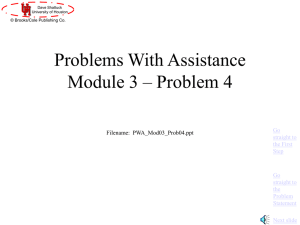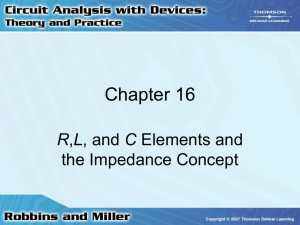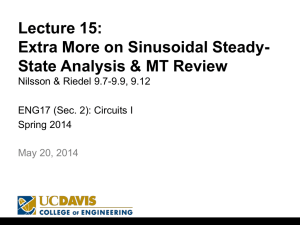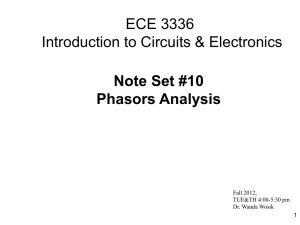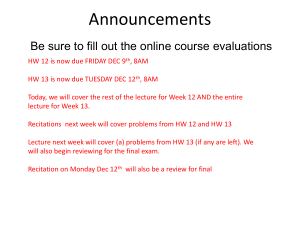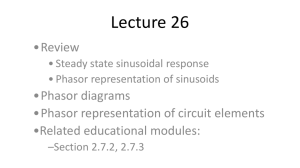PWA_Mod08_Prob06_v04
advertisement
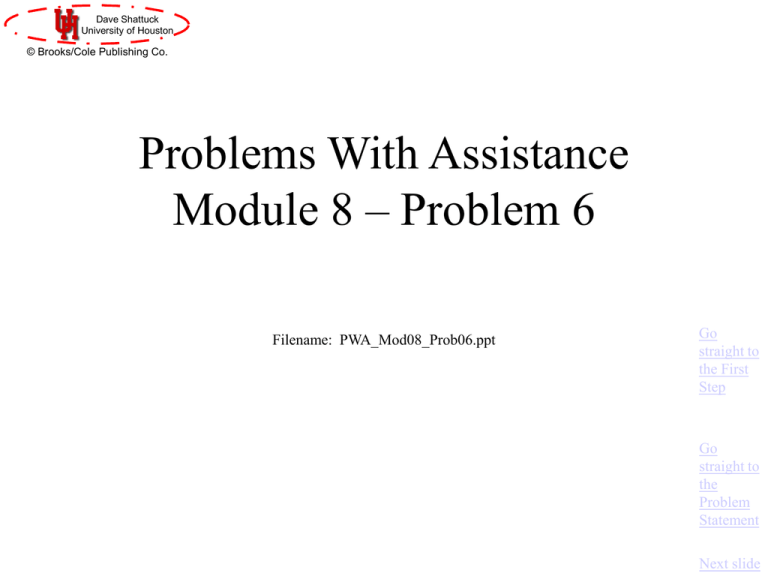
Dave Shattuck University of Houston © Brooks/Cole Publishing Co. Problems With Assistance Module 8 – Problem 6 Filename: PWA_Mod08_Prob06.ppt Go straight to the First Step Go straight to the Problem Statement Next slide Dave Shattuck University of Houston © Brooks/Cole Publishing Co. Overview of this Problem In this problem, we will use the following concepts: • Phasor Analysis • Equivalent Circuits in the Phasor Domain • Finding Ratios, such as Gains or Transfer Functions Go straight to the First Step Go straight to the Problem Statement Next slide Dave Shattuck University of Houston © Brooks/Cole Publishing Co. Textbook Coverage The material for this problem is covered in your textbook in the following chapters: • Circuits by Carlson: Chapter 6 • Electric Circuits 6th Ed. by Nilsson and Riedel: Chapter 9 • Basic Engineering Circuit Analysis 6th Ed. by Irwin and Wu: Chapter 8 • Fundamentals of Electric Circuits by Alexander and Sadiku: Chapter 9 • Introduction to Electric Circuits 2nd Ed. by Dorf: Chapter 11 Next slide Dave Shattuck University of Houston © Brooks/Cole Publishing Co. Coverage in this Module The material for this problem is covered in this module in the following presentations: • DPKC_Mod08_Part01, DPKC_Mod08_Part02, and DPKC_Mod08_Part03. Next slide Dave Shattuck University of Houston © Brooks/Cole Publishing Co. Problem Statement Find the ratio of the phasor of the output voltage vO(t), to the phasor of the input voltage vS(t), as a function of the angular frequency, w. In other words, find Vo/Vs(w). C1= 1[mF] Rp = 820[W] iC= b iB C2= 0.1[mF] + iB vO(t) + vS(t) RL = 10[kW] - vS(t) = VSm cos (wt) b = 200 This problem is significant because it is a common relationship to find for amplifiers. This ratio, called the transfer function, tells us the gain (or how much the signal gets bigger), along with the phase shift of the output with respect to the input, both as a function of frequency. Next slide Dave Shattuck University of Houston © Brooks/Cole Publishing Co. Solution – First Step – Where to Start? Find the ratio of the phasor of the output voltage vO(t), to the phasor of the input voltage vS(t), as a function of the angular frequency, w. In other words, find Vo/Vs(w). C1= 1[mF] Rp = 820[W] iC= b iB C2= 0.1[mF] + iB vO(t) + vS(t) RL = 10[kW] - vS(t) = VSm cos (wt) b = 200 How should we start this problem? What is the first step? Next slide Dave Shattuck University of Houston Problem Solution – First Step © Brooks/Cole Publishing Co. Find the ratio of the phasor of the output voltage vO(t), to the phasor of the input voltage vS(t), as a function of the angular frequency, w. In other words, find Vo/Vs(w). C1= 1[mF] Rp = 820[W] iC= b iB C2= 0.1[mF] + iB vO(t) + vS(t) RL = 10[kW] - vS(t) = VSm cos (wt) b = 200 How should we start this problem? What is the first step? a) Apply superposition b) Convert the circuit to the phasor domain c) Find the open-circuit voltage d) Find the short-circuit current Dave Shattuck University of Houston Your Choice for First Step – Apply superposition © Brooks/Cole Publishing Co. Find the ratio of the phasor of the output voltage vO(t), to the phasor of the input voltage vS(t), as a function of the angular frequency, w. In other words, find Vo/Vs(w). C1= 1[mF] Rp = 820[W] iC= b iB C2= 0.1[mF] + iB vO(t) + vS(t) RL = 10[kW] - vS(t) = VSm cos (wt) b = 200 This is not a good choice for the first step. Superposition will not help with this problem. Superposition can be useful when we have more than one independent source. We have only one independent source. Go back and try again. Dave Shattuck University of Houston Your Choice for First Step – Find the open-circuit voltage © Brooks/Cole Publishing Co. Find the ratio of the phasor of the output voltage vO(t), to the phasor of the input voltage vS(t), as a function of the angular frequency, w. In other words, find Vo/Vs(w). C1= 1[mF] Rp = 820[W] iC= b iB C2= 0.1[mF] + iB vO(t) + vS(t) RL = 10[kW] - vS(t) = VSm cos (wt) b = 200 This is not a good choice. It is true that we will be finding the output voltage for this circuit. However, this is the goal, not the first step. Just as important, we want to find the phasor of the output voltage, not the voltage itself. Go back and try again. Dave Shattuck University of Houston Your Choice for First Step – Find the short-circuit current © Brooks/Cole Publishing Co. Find the ratio of the phasor of the output voltage vO(t), to the phasor of the input voltage vS(t), as a function of the angular frequency, w. In other words, find Vo/Vs(w). C1= 1[mF] Rp = 820[W] iC= b iB C2= 0.1[mF] + iB vO(t) + vS(t) RL = 10[kW] - vS(t) = VSm cos (wt) b = 200 This is not a good choice. The short-circuit current will not help us solve this problem. This would be useful if we were to find the Thevenin Equivalent. We are not trying to do that. Go back and try again. Dave Shattuck University of Houston © Brooks/Cole Publishing Co. Your Choice for First Step – Convert the circuit to the phasor domain Find the ratio of the phasor of the output voltage vO(t), to the phasor of the input voltage vS(t), as a function of the angular frequency, w. In other words, find Vo/Vs(w). C1= 1[mF] Rp = 820[W] iC= b iB C2= 0.1[mF] + iB vO(t) + vS(t) RL = 10[kW] - vS(t) = VSm cos (wt) b = 200 This is a good choice for the first step. Since we have only one independent source, and it is sinusoidal, performing the Phasor Transform is appropriate. Our desired solution is in the phasor domain, so let’s convert. Dave Shattuck University of Houston Converting to the Phasor Domain and Solution Methods © Brooks/Cole Publishing Co. Find the ratio of the phasor of the output voltage vO(t), to the phasor of the input voltage vS(t), as a function of the angular frequency, w. In other words, find Vo/Vs(w). ZC1= (1/jw10-6)[W] ZR p = 820[W] Ic= 200Ib ZC2= (1/jw10-7)[W] + Ib + - Vs(w)= VSm Vo(w) ZRL= 10[kW] - For w in [rad/s] We have converted the circuit to the phasor domain. The angular frequency, w, is the independent variable in this problem. We want to solve for the ratio Vo/ Vs. There are several ways to approach this kind of problem. In general, the goal is to write n equations in n+1 unknowns, where two of the unknowns are Vo and Vs. Then, the system of equations is reduced to 1 equation, with these two unknowns. Finally, we solve for the ratio. Often, though, a simpler method is followed. Dave Shattuck University of Houston Solution Methods – 2 © Brooks/Cole Publishing Co. Find the ratio of the phasor of the output voltage vO(t), to the phasor of the input voltage vS(t), as a function of the angular frequency, w. In other words, find Vo/Vs(w). ZC1= (1/jw10-6)[W] ZR p = 820[W] Ic= 200Ib ZC2= (1/jw10-7)[W] + Ib + - Vs(w)= VSm Vo(w) ZRL= 10[kW] - For w in [rad/s] While we could write n equations in n+1 unknowns, and then solve for the ratio of Vo to Vs, often a simpler method is followed. There are several methods available. In these modules we are going to use a test-source method. The reasons are that it is essentially the same method we use for Thevenin Resistance calculations, and we do not need to have calculators that have symbolic complex algebra functionality. Dave Shattuck University of Houston Solution Methods – Test Source Method © Brooks/Cole Publishing Co. Find the ratio of the phasor of the output voltage vO(t), to the phasor of the input voltage vS(t), as a function of the angular frequency, w. In other words, find Vo/Vs(w). ZC1= (1/jw10-6)[W] ZR p = 820[W] Ic= 200Ib ZC2= (1/jw10-7)[W] + Ib + - Vs(w)= VSm Vo(w) ZRL= 10[kW] - For w in [rad/s] We are going to use the test-source method. In this method, we replace the general source, in this case Vs, with a specific source with some convenient value, such as 1[V]. Then we solve for Vo, and take the ratio of Vo / Vs which is therefore Vo /1[V]. The concept here is that the ratio should be the same for any input. Why not take a convenient value, if we are just going to divide by it anyway? This is the test-source method. Let’s try it out. Dave Shattuck University of Houston Applying the Test Source Method – 1 © Brooks/Cole Publishing Co. Find the ratio of the phasor of the output voltage vO(t), to the phasor of the input voltage vS(t), as a function of the angular frequency, w. In other words, find Vo/Vs(w). ZC1= (1/jw10-6)[W] ZR p = 820[W] Ic= 200Ib ZC2= (1/jw10-7)[W] + Ib + Vo(w) Vs(w)= VSm - ZRL= 10[kW] For w in [rad/s] We start by setting Vs = 1[V]. Then, we can write an equation for Ib, Ib Ib 1[V] . To simplify this, we multiply top and bottom by jw106 , 1 820 [W] 6 jw10 jw106 [A] 820 jw10 1 6 . Next slide Dave Shattuck University of Houston Applying the Test Source Method – 2 © Brooks/Cole Publishing Co. Find the ratio of the phasor of the output voltage vO(t), to the phasor of the input voltage vS(t), as a function of the angular frequency, w. In other words, find Vo/Vs(w). ZC1= (1/jw10-6)[W] Ic= 200Ib ZR p = 820[W] ZC2= (1/jw10-7)[W] + Ib + - Vo(w) Vs(w)= VSm ZRL= 10[kW] For w in [rad/s] Next, we write an expression for Vo, Vo 200 Ib Z RL . Plug in the values, and we get Vo 200 jw106 [A] 820 jw10 1 6 10, 000[W] jw 2[V] . 6 jw820 10 1 Next slide Dave Shattuck University of Houston Applying the Test Source Method – 3 © Brooks/Cole Publishing Co. Find the ratio of the phasor of the output voltage vO(t), to the phasor of the input voltage vS(t), as a function of the angular frequency, w. In other words, find Vo/Vs(w). ZC1= (1/jw10-6)[W] Ic= 200Ib ZR p = 820[W] ZC2= (1/jw10-7)[W] + Ib + - Vo(w) Vs(w)= VSm ZRL= 10[kW] For w in [rad/s] Finally, we divide this by Vs = 1[V], and we get Vo V o Vs 1[V] jw 2[V] jw 820 106 1 1[V] jw 2 . 6 jw 820 10 1 As noted in the figure above, this solutions assumes w has units of [rad/s]. Go to comments slide Dave Shattuck University of Houston © Brooks/Cole Publishing Co. How can I just assume the source is 1[V]? • This is an excellent question. We don’t know that the source is 1[V]. So, how can we assume it? • The answer is that we are making a temporary assumption, just the purposes of finding a ratio. We need to remember this. • The premise is that we are looking for a ratio that will be valid for any value of the source that we choose. Therefore, it should not matter what value we choose. The ratio should be the same no matter what. So, just to have something to plug into our calculators, we pick a value. We then divide by that value in the last step, to get the ratio. Go back to Overview slide.

